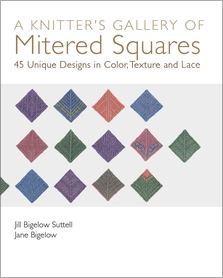Book Review
In the late '90s, mitered squares and their entrelac cousins were synonymous with brightly colored, variegated novelty yarns. The mitered square was a useful way to break up the flatness of horizontal color stripes, pitching the rows diagonally in a pointed V. These furry, sparkly, shapeless, and chaotic vests didn't always enhance the innate beauty of the wearer, which may be part of why they fell out of favor.
The Miter Returns
The mother-daughter duo of Jill Bigelow-Suttell and Jane Bigelow want to show the mitered square in a fresh new light. Having owned an LYS for a decade and traveled the country teaching workshops, they worked up swatch after swatch until they had something they believed was ready for public consumption.
Instead of taking their proposal to a publisher, they took it straight to the public as a Kickstarter campaign. It received full funding, and today a beautiful glossy book exists.
The Book
It's called A Knitter's Gallery of Mitered Squares because, at the core, that's exactly what this is: a collection of 45 mitered square patterns. The motifs are divided among three categories that sometimes overlap: color, texture, and lace. The yarns used for the samples are all smooth and solid-hued, with nary a sequin or eyelash to be found.
But first, you'll find brief basics on how mitered squares work—especially helpful if you've never done them before. What you see in the chart and what you see on your needles won't immediately match what you see in the finished picture. Take out some yarn for a swatch, try one of the motifs, and you'll see what I mean.
Next, the authors offer helpful information on how to pick up a square (when working, say, a blanket of squares), and basically show you how the miter will orient itself. For those times when you want to pitch your squares on their tips, you'll also find details on how to pick up squares "on point," so that your squares nest, diamond-like, one into the next.
A more interesting tip is tucked quietly here: How to work only edges of squares, so that you can nest half a square within the V of two other squares and achieve a smooth edge to your fabric. You'll learn how to convert your squares to left, right, and top triangles. Then, they present the simpler technique of stacking squares one on top of another, the edges working as a standard horizontal/vertical grid.
The Motifs
The squares in the Color section feature various stripes and color sequences using two colors of yarn. The squares in the Texture section offer some compelling motifs that are attractive in their own right, not just adaptations of familiar patterns. They use slipped stitches, garter, purls, stripes, and even bobbles to achieve their designs.
The line between the Lace and Texture squares is a little blurry, since both employ combinations of the YO and SSK/SKP. But, again, the motifs are interesting. Just leafing through the pages, my fingers twitched in that eager-to-cast-on way.
A Class Act
Everything here has the utter simplicity and clarity of well-honed teaching materials that have been tested and refined, class after class, into something approaching haiku.
Each stitch gets its own spread in the book, with a full-color photograph on the left side, chart on the right. Under the photograph, they've added what they call an Adaptability Rating. This is done to help you understand how easily this particular pattern can be sized up or down for different kinds of projects. Ratings run from easily resized, those that will require a bit more math, and those best left alone.
Charting New Territory
The charts will be easy to understand once you learn their system: They begin at the bottom left (most charts start on the bottom right), and odd-numbered rows are wrong-side rows (usually they're right-sided).
A key below each chart tells you the abbreviation for each symbol. The abbreviations themselves are explained in the glossary in back. There is no photographic "how to work a knit stitch" kind of tutorial up front; they assume you already know the basics.
There were just a few odd chart symbols (pw2x and k2wx for example) that you'll quickly remember. Likewise, a little lingo—such as Pu&k—might be new to you.
The Projects
The book concludes with four patterns. The authors are emphatic about these patterns being merely springboards for your own adaptation and creativity. Mitered squares are somewhat peculiar creations, and it helps to show them in some kind of finished-item context here.
The Frosty Sunrise Scarf is the easiest, basic lace square scarf. The Harvest Celebration continues the rectangular motif but works the squares in different directions. Misty Valley shows how to add mitered squares to a vest that's otherwise smooth stockinette. Finally, Aurora Night, an all-mitered-square vest in two colors, is closest to what you might think of when I say "mitered squares."
Bravo for Brevity
Self-published books sometimes suffer from a lack of rigorous editing, but not here. An economy of space prevails. Only in the Acknowledgements do they allow themselves the luxury of extra words, all well-earned.
In clothing, mitered squares still pose a bit of a design challenge. They work as triangles and squares. How do we insert them artfully into something that, by its very nature, needs to have more subtle shaping? Also, because the stitches run on the diagonal, mitered squares differ in terms of drape, stretch, and overall impact on the surrounding fabric.
Leave those design considerations aside for a minute. Mitered squares are beautiful in their own right. Each is a concise puzzle that contains challenges and surprises that unfold as you go along. They deserve to become part of your daily swatch regimen, and this book is all you'll need to get started.

